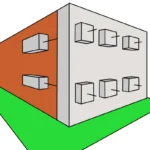Impact of Settlements on Buildings

When we gaze upon a building, it’s common to assume it remains static and unchanged over time. However, behind its seemingly immutable appearance, a natural process operates, influencing the position and stability of the structure: settlements.
What are building settlements?
Building settlements refer to the vertical variations experienced by a structure as it undergoes loads and adjusts to its location. These movements are mostly the result of soil compression or the foundation upon which the building rests. We’ll delve into two fundamental categories of settlements: elastic settlement and consolidative settlement.
Elastic settlement: This type of settlement occurs immediately after the construction of a building. As the structure bears its weight and live loads, such as furniture and people, the soil or foundation gradually compresses. This results in a progressive descent of the building in its position. Fortunately, this type of settlement is predictable and taken into account during the design and construction phase. Engineers assess soil properties and structure weight to ensure uniform and secure settlement.
Consolidative settlement: In contrast to elastic settlement, consolidative settlement is a process that unfolds over time. This phenomenon is attributed to the additional compression of the soil under the constant load of the structure. Its origin may lie in factors such as the gradual expulsion of water from the soil pores or the continuous compression of the soil. Consolidative settlements are more complex to anticipate and control, and if not managed properly, they can lead to structural problems.
Consequences of Unexpected Settlements
Here, we discuss some consequences of unexpected settlements:
Structural Damage: Settlements can cause damage to the building structure, including cracks in walls, ceilings, beams, and columns. These damages reduce the building’s resistance and can endanger its long-term stability.
Uneven Floors and Walls: Unequal settlements can lead to uneven floors and walls. This not only affects the aesthetics of the space but can also create functional problems, such as difficulty in installing furniture or equipment.
Issues with Mechanical and Electrical Systems: Settlements can damage systems like pipes, air conditioning ducts, and electrical cables. This can result in leaks, blockages, and short circuits, requiring costly repairs.
Difficulties in Door and Window Operation: When a building settles unevenly, doors and windows can deform, making it challenging to open and close them. This affects the comfort and safety of occupants.
Appearance of Cracks: Cracks in walls and ceilings are a common consequence of settlements. These openings can allow moisture and air to enter, leading to leakage problems, mold, and structural deterioration.
Structural Instability: In severe cases, settlements can result in significant structural instability. This endangers the safety of people occupying the building and may require emergency measures to prevent collapse.
Functionality Issues: Settlements can alter the functionality of a building. For example, leaning staircases, unusable work areas, or uncomfortable spaces can render the building unfit for its intended purpose.
Property Depreciation: Buildings affected by settlements can lose value in the real estate market. Buyers or tenants may be deterred by the prospect of expensive repairs and ongoing problems.
Continuous Maintenance Costs: Buildings with settlements often require constant and expensive maintenance to address arising issues. This may include structural repairs, material replacement, and periodic monitoring.
How are Settlements Predicted and Who Handles It?
The prediction and management of settlements in buildings are essential tasks handled by experts in geotechnical and structural engineering, as well as other construction professionals. In the following section, we will break down how this process is carried out and who is responsible for its execution:
Geotechnical Study: The first step in anticipating settlements involves conducting a thorough geotechnical study at the site where the building will be erected. Geotechnical engineers lead this process. The geotechnical study includes the investigation of soil type, load-bearing capacity, compressibility, and other geological factors crucial for assessing potential settlements.
Soil Tests: Within the geotechnical study, specific soil tests, such as standard penetration tests (SPT) or cone penetration tests, are conducted. These tests provide crucial data about soil properties, contributing to the identification of the terrain’s load-bearing capacity and its response under various loads.
Mathematical Modeling: Using the information gathered in the geotechnical study, engineers employ mathematical models and geotechnical analysis software to anticipate expected settlements. These models consider variables such as the magnitude of the structural load, soil geotechnical characteristics, and foundation arrangement.
Design of Appropriate Foundations: Based on settlement predictions, structural engineers design the building’s foundations to evenly distribute loads and minimize settlements. This process may involve choosing shallow foundations, such as foundation slabs, or deep foundations, such as piles, depending on the specific project requirements.
Monitoring and Control: Once the building is operational, constant monitoring is established to assess actual settlements and compare them with previous predictions. This is done through the installation of geotechnical instrumentation, such as piezometers or inclinometers, responsible for measuring changes in the soil and structure.
Corrective Measures: In the event of unexpected or uneven settlements exceeding permissible limits, corrective measures must be implemented. These may involve grout injection (a mixture of cement and water) under the structure to lift it or the introduction of reinforcement systems, all aimed at safeguarding the building’s integrity.
Cases Where Settlements Have Occurred
- Leaning Tower of Pisa, Italy:
One of the most famous examples of settlements is the Leaning Tower of Pisa in Italy. This iconic tower, built in the 12th century, began leaning shortly after the construction of its third floor due to differential settlements in the soil. The tower rests on clayey and sandy soils prone to compression. Over the years, engineering work has been carried out to stabilize it and prevent collapse.

- Royal Palace of Amsterdam, Netherlands:
The Royal Palace of Amsterdam, known as the “Koninklijk Paleis,” is a majestic construction located in the heart of the city. During its construction in the late 17th century, over 13,000 wooden piles were used to settle the structure in swampy and clayey soils characteristic of the area. Over the years, natural soil settlements have caused sinking in some parts of the palace, necessitating restoration and structural reinforcement work to preserve its integrity.

- Palace of Fine Arts, Mexico City, Mexico:
The Palace of Fine Arts, an architectural and cultural gem of Mexico, was built in Mexico City in the early 20th century. It is located in an area that was formerly part of Lake Texcoco, meaning the soil is prone to settlements due to its expansive clay composition. Over the years, this majestic building has experienced differential settlements, resulting in deformations and displacements in its structure. These settlements manifest as cracks in the walls and dome of the building. To address this issue, engineering work has been undertaken to stabilize and restore the structure, including the implementation of monitoring systems to detect real-time changes and the execution of corrective measures to preserve its architectural and cultural integrity.

Conclusion:
Settlements are natural processes that influence the position and stability of buildings over time. They can be elastic, occurring immediately after construction, or consolidative, developing over time. These settlements can have significant consequences, from structural damage to functional problems and continuous maintenance costs.
However, thanks to geotechnical and structural engineering, as well as other construction professionals, it is possible to predict, manage, and mitigate these settlements. Comprehensive geotechnical studies, soil tests, mathematical modeling, and the design of appropriate foundations ensure the safety and stability of buildings. Additionally, constant monitoring and corrective measures when necessary are integral parts of this process.
“In the construction of our dreams, we face settlements as inevitable challenges. But remember, each settlement is an opportunity to strengthen the foundations of your goals and reach new heights. The resilience of your spirit is the basis of your achievements.”






Related
What Is Soil Moisture?
Importance of Slope Stability in Engineering
What is Geodynamics? – the study of Earth’s changes